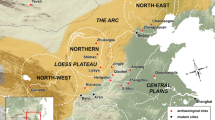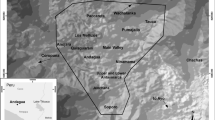Abstract
The Trujillo Homesteads National Historic Landmark encompasses two 19th-century Hispanic American ranches on the western edge of the Great Sand Dunes National Park and Preserve in the San Luis Valley of south central Colorado. These sites are the 1865 Teofilo and Andrellita Trujillo homestead and the 1879 homestead of their son and his wife, Pedro and Sofia Trujillo. The Trujillo homesteads are associated with a broad pattern of United States history: the northward movement of Hispanic Americans into the newly acquired southwesternmost region of the American frontier. They represent a pattern of dispersed, independent settlement by individuals who focused on amassing public lands rather than following the area’s established pre-1848 tradition of founding colonies on Mexican land grants. The historical archaeology components of the two homesteads further understanding of the nation’s early Hispanic American legacy and interactions on the borderlands among Hispanic, Native American, and European American cultures and economic interests on the American frontier.
Resumen
El Monumento Histórico Nacional Trujillo Homesteads abarca dos ranchos hispanoamericanos del siglo XIX en el borde occidental del Parque Nacional y Reserva Great Sand Dunes en el Valle de San Luis en el centro sur de Colorado. Estos sitios son el patrimonio de familia (o homestead) de Teófilo y Andrellita Trujillo en 1865 y, en 1879, el patrimonio de familia de su hijo y su esposa, Pedro y Sofía Trujillo. Los Trujillo Homesteads están asociados con un patrón amplio de la historia de los Estados Unidos: el movimiento hacia el norte de los hispanoamericanos hacia la región más al sudoeste de la frontera estadounidense recién adquirida. Representan un patrón de asentamiento disperso e independiente de personas que se concentraron en acumular tierras públicas, en lugar de seguir la tradición establecida en el área anterior a 1848 de fundar colonias en mercedes de tierras mexicanas. Los componentes de arqueología histórica de los dos ranchos mejoran la comprensión del legado temprano hispanoamericano de la nación y las interacciones en las tierras fronterizas entre las culturas e intereses económicos hispanos, nativos americanos y euroamericanos en la frontera estadounidense.
Résumé
Le site historique national des résidences Trujillo se compose de deux fermes hispano-américaines du 19ème siècle situées sur la pointe occidentale du Parc national et réserve des Great Sand Dunes dans la Vallée San Luis de la région centrale du sud du Colorado. Ces sites sont la demeure datant de 1865 de Teofilo et Andrellita Trujillo et celle datant de 1879 de leur fils et de son épouse, Pedro et Sofia Trujillo. Les résidences Trujillo sont associées à un vaste modèle de l'histoire des États-Unis : le mouvement en direction du nord des Hispano-Américains dans la région nouvellement acquise de l'extrême sud-ouest de la frontière américaine. Elles représentent un modèle d'implantation dispersée, indépendante par des individus dont la priorité était d'amasser des terres publiques, plutôt que de suivre la tradition établie dans la région antérieurement à 1848 d'une fondation de colonies sur des terrains mexicains alloués. Les composantes d'archéologie historique des deux résidences permettent d'affiner la connaissance de l'héritage précoce hispano-américain de la nation, des interactions sur les régions frontalières entre les cultures hispanique, amérindienne et européenne américaine et des intérêts économiques sur la frontière américaine.









Similar content being viewed by others
References
Carrillo, Richard F. 2007 Ethnicity. In Colorado History: A Context for Historical Archaeology, Minette C. Church, Steven G. Baker, Bonnie J. Clark, Richard F. Carrillo, Jonathon C. Horn, Carl D. Spath, David R. Guilfoyle, and E. Steve Cassells, editors, pp. 177–256. Colorado Council of Professional Archaeologists, Denver.
Deutsch, Sarah 1987 No Separate Refuge: Culture, Class, and Gender on an Anglo-Hispanic Frontier in the American Southwest, 1880–1940. Oxford University Press, New York, NY.
Dittert, Alfred E., Jr., and Fred Plog 1980 Generations in Clay: Pueblo Pottery of the American Southwest. Northland, Flagstaff, AZ.
Gibson, Charles E., Jr. 1933–1934 The Original Settler at Medano Springs. Manuscript, CWA Pioneer Interviews Collection, History Colorado, Stephen H. Hart Research Center, Denver, CO. The Original Settler at Medano Springs [File 349.23], History Colorado Online Collection, History Colorado <https://5008.sydneyplus.com/HistoryColorado_ArgusNet_Final/Portal/Portal.aspx?component=AAFW&record=5ee9e2d8-be9d-4266-9824-64d5f6a93981>. Accessed 22 June 2022.
Gunnerson, James H. 1978 An Introduction to Plains Apache Archeology—the Dismal River Aspect. J & L Reprint Company, Lincoln, NE.
Martorano, Marilyn A. 2007 Archaeological Assessment of the Teofilo Trujillo Homestead (5AL791), Alamosa County, Colorado, State Historic Fund Project #2006-AS-009. Report to History Colorado, Office of Archaeology and Historic Preservation, Denver, from RMC Consultants, Inc., Lakewood, CO.
Martorano, Marilyn A., Ted Hoefer III, David Killam, and Dolly McClellan 2002 Management Data Form and Historical Archaeology Component Form, Site 5AL706. Manuscript, History Colorado, Office of Archaeology and Historic Preservation, Denver.
Orser, Charles E., Jr. 2007 The Archaeology of Race and Racialization in Historic America. University Press of Florida, Gainesville.
Reed, Lori S. 2006a Ceramic Analysis of Site 5AL706, the Pedro Trujillo Homestead. Report to RMC Consultants, Inc., Lakewood, CO, from Animas Ceramic Consulting, Inc., Farmington, NM.
Reed, Lori S. 2006b Ceramic Analysis of Site 5AL791, the Teofilo Trujillo Homestead. Report to RMC Consultants, Inc., Lakewood, CO, from Animas Ceramic Consulting, Inc., Farmington, NM.
Sanchez, Virginia 2010 Forgotten Cuchareños of the Lower Valley. History Press, Charleston, SC.
Simmons, Virginia McConnell 1999 The San Luis Valley: Land of the Six-Armed Cross, 2nd edition. University Press of Colorado, Niwot.
Simmons, R. Laurie, and Marilyn A. Martorano 2007 Guns, Fire, and Sheep: History and Archaeology of the Trujillo Homesteads in the San Luis Valley, Colorado. Southwestern Lore 73(3):1–20.
Simmons, R. Laurie, and Thomas H. Simmons 2003 Trujillo Homestead, 5AL706, 16 December. National Register of Historic Places Nomination Form, National Park Service, U.S. Department of the Interior, Washington, DC. Colorado SP Trujillo Homestead, National Archives Catalog <https://catalog.archives.gov/id/84128164>. Accessed 21 June 2022.
Simmons, Thomas H., R. Laurie Simmons, and Marilyn A. Martorano 2011 Trujillo Homesteads, 23 September. National Historic Landmark Nomination Form, National Historic Landmarks Survey, National Park Service, Washington, DC.
Tushar, Olibama Lopez 2007 The People of El Valle: A History of Spanish Settlers in the San Luis Valley, 4th edition. El Escritorio, Pueblo, CO.
White, David R. M. 2005 Seinanyéd: An Ethnographic Overview of Great Sand Dunes National Park and Preserve. Report to Great Sand Dunes National Park and Preserve, Mosca, CO, from Applied Cultural Dynamics, Santa Fe, NM.
Acknowledgments:
Special thanks to Laurie and Tom Simmons for their tireless efforts to document and research these two homesteads. Many thanks also to the numerous individuals who supported the research and the fieldwork, including Fred Bunch, Adrienne Anderson, Meg Van Ness, Charlie Haecker, David White, Bob Linger, Richard Carrillo, David Killam, Tad and Casey Carpenter, Andrew Valdez, Kathy Faz, Ted Hoefer III, Chris Bevilacqua, Steven Sundjordet, Dolly McClellan, Marvin Goad, Michelle Slaughter, Maria Martinez, Astrid Liverman, Sal Martorano, and the many fieldwork volunteers who assisted us over the years. We also appreciate all of the Trujillo family descendants who shared their family histories, especially Andrea Trujillo Lujan, Maria Tita Causby, and Deborah Quintana. Gratitude is extended to History Colorado and the Colorado State Historical Fund, the Nature Conservancy, and the Rio Grande County Museum for their funding support. The technical assistance and logistical support from numerous employees at Great Sand Dunes National Park and Preserve, the Nature Conservancy, the Medano-Zapata Ranch, and the San Luis Valley Archaeological Network is also appreciated.
Funding
The survey, site documentation, and National Register of Historic Places and National Historic Landmark nomination projects on both homesteads were funded by the National Park Service and the History Colorado State Historical Fund (through the Nature Conservancy and the Rio Grande County Museum).
Author information
Authors and Affiliations
Corresponding author
Ethics declarations
Conflict of Interest
The author worked for RMC Consultants, Inc., during all of the projects listed above.
Additional information
Publisher’s Note
Springer Nature remains neutral with regard to jurisdictional claims in published maps and institutional affiliations.
Rights and permissions
About this article
Cite this article
Martorano, M.A. Struggle, Strength, and Survival: The Trujillo Homesteads National Historic Landmark and Hispanic American Settlement in the Mid-Nineteenth Century. Hist Arch 56, 511–523 (2022). https://doi.org/10.1007/s41636-022-00362-3
Accepted:
Published:
Issue Date:
DOI: https://doi.org/10.1007/s41636-022-00362-3




